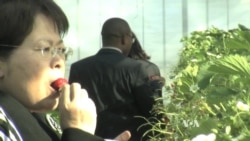In the shadow of northern Japan’s snow-capped mountains, Kazuhiro Watanabe’s strawberries are plump and ready for picking; because of his advanced greenhouses, the crop is ripe for harvest even in early spring.
But the succulent fruit has proved difficult to sell in recent seasons - for Watanabe’s greenhouses are in Fukushima, albeit a long way from the region's crippled nuclear power plant.
“I was in the middle of the strawberry growing season when the earthquake struck. After that I lost half my customers," he said, adding that business has slowly been improving.
Watanabe said according to the latest surveys, sales of produce from Fukushima are now around 70 to 80 percent of the sales volumes of produce from other parts of Japan. So, gradually, people’s minds are changing.
UN conference
Thousands of delegates from around the world gathered for a U.N. conference on disaster risk reduction this week in northeast Japan, where an earthquake-tsunami led to a nuclear disaster at Tokyo Electric Power Co's (TEPCO) Fukushima Daiichi nuclear power plant four years ago.
Local authorities used the conference, and a tour of the local area, to showcase efforts to revitalize the region and dispell concerns over food safety following the radiation leak.
At the Fukushima Agricultural Technology Center, a team of workers in masks and laboratory coats is cutting and mashing fish, chicken and vegetables, before they are put in the latest U.S.-made radiation detectors.
All local produce from the region is tested for cesium isotopes. Authorities said Japanese safety standards are 10-times stricter for levels of radioactive cesium than in the United States and Europe.
The Center’s manager, Katsumi Komaki, emphasizes the international oversight of their activities.
Komaki said they have cooperated with international organizations, including the International Atomic Energy Agency, in order to research the rate of absorption of radioactive materials by rice and other agricultural products.
Next stop is a factory producing more than 3,000 school meals every day, which are also tested for radiation. Samples are put in a blender before undergoing radioactive testing. Spokesperson Atsuko Kano said the process aims to be completely transparent.
Kano said that they provide the test results on the Fukushima city website. They also send out information to every parent about the ingredients in the lunches.
Food reaching the market
Fukushima is fighting hard to get back on its feet - and the region is using the arrival of thousands of foreign delegates to showcase its efforts. Local government official Mayumi Suzuki organized the tour.
“The image of Fukushima is not really good in the world. But this is my dream that I want to tell all the people what’s really happening in Fukushima and that’s why I’m organizing such a tour," Suzuki said.
Independent monitoring from environmental groups has revealed "hotspots" of radiation in some areas of Fukushima -- but no evidence of radiation in food reaching the market.
In a region once famous in Japan for its produce, farmers and fishermen are desperately trying to reclaim the Fukushima name still synonymous with the nuclear accident.











